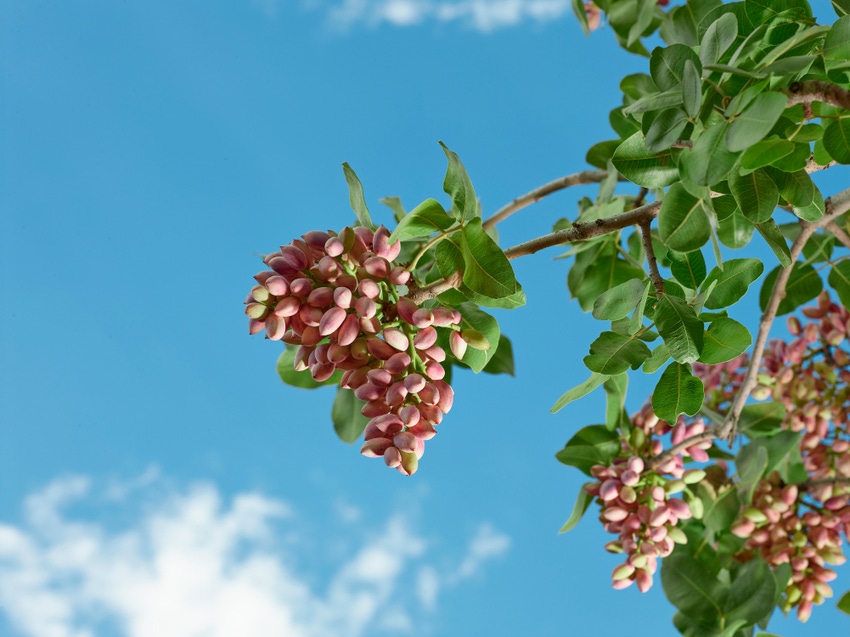
A monitoring tool that will alert pistachio growers to leaffooted bug pressure is in the sights of researchers.
“Right now, we do visual inspections for presence of this pest. We need a much more efficient and accurate way of knowing the risks,” says Brad Higbee, director of entomology research for Wonderful Orchards.
“It is a long, tedious process, testing the different components. Pomegranates tend to be a likely place to find leaffooted bugs, so we directed our testing there,” he added.
Since 2015, Higbee and USDA chemist John Beck have worked on the development of attractants based on host volatiles (kairomones) for leaffooted bugs. Their goal is to formulate a blend of pomegranate-based volatiles for use as a lure for these large seed-feeding pests that move from native host plants into pistachio and almond orchards and cause crop damage.
Monitoring populations could answer questions about overwintering survival, initiation of egg laying, and when treating overwintering aggregations are best achieved.
Similar work has been done by Higbee to determine the best attractants for Navel orangeworm in almonds and pistachios. Finding the right combination of volatiles to lure leaffooted bugs is a long process, he says. As nut damage due to the pest continues to increase, growers need tools to control it.
One of the most favored host plants of the leaffooted bug is the pomegranate. Higbee’s work involves using split pomegranates, identifying the individual components, and determining which of the hundreds of volatiles derived from the emissions of split pomegranates are important in attracting leaffooted bugs.
The next step is testing individual kairomones and mixtures to find the best attractant for male and female leaffooted bugs.
University of California (UC) Integrated Pest Management Advisor Kris Tollerup says the ability to forecast leaffooted bug pressure is vital to planning crop protection strategies. Entomologists know that a pheromone plays a key role in cueing the pest to aggregate but a precise compound has not yet been identified.
Referred to by many entomologists as a “beast of a bug,” the leaffooted bug is tough to lure and tougher to kill. Adults readily fly away when disturbed.
Organophosphates are effective on contact and have about a week of residual activity. Newer softer chemistries on beneficials have some contact activity, but no residual. There are no cultural or biological controls available.
Temperatures below 27 degrees Fahrenheit decrease overwinter survival, but many new plantings of pistachios are located in warmer areas which lack freezing temperatures every year.
Leaffooted bugs are found throughout the Southwest. In California, the pest can produce three and a half overlapping generations per season. There are five instars and it takes about 42 days to grow from egg to adult. Adults live for about 50 days.
Later instars and adults have the greatest potential for causing damage to pistachio crops due to stronger piercing mouthparts that can penetrate developing nut shells. Aggregations begin to form in the fall. The movement into pistachios for feeding begins in May.
Tollerup says large numbers of leaffooted bugs can cause considerable crop damage in a short time. Monitoring for overwinter numbers should be done March through June. Treatment is suggested if large numbers of leaffooted bugs are present, if gummosis is found on nuts, or excessive nut drop is observed.
Researchers have also suggested a relationship between leaffooted bug infestations and pathogenic infections.
UC Agriculture and Natural Resources Plant Pathologist Themis Michailides, in a demonstration at the UC Kearney Research and Extension Center, showed how damage from feeding leaffooted bugs and stink bugs can lead to increased diseases, including Botryosphaeria panicle and shoot blight of pistachios.
Michailides noted that the disease in almonds is very similar to stigmatomycosis in pistachio. Early damage by feeding insects can result in nut drop. Later damage can cause decay and black spots on kernels making them unmarketable.
About the Author(s)
You May Also Like




